From the February 2016 issue of GCM magazine:
Present and accounted for
In the shadow of Monticello, 2016 President’s Award for Environmental Stewardship winner Peter McDonough has made some history of his own, proving how much can be accomplished simply by showing up.
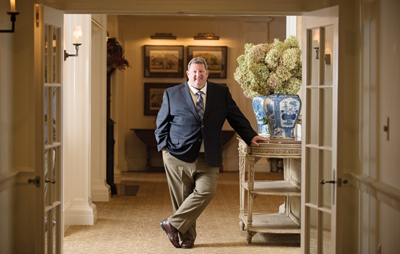
Peter McDonough, the superintendent at Keswick Hall and Golf Club in Keswick, Va., and the recipient of GCSAA’s 2016 President’s Award for Environmental Stewardship.
Photo by Ashley Twiggs
Scott Hollister
Read this story in GCM's digital edition »
Riverside Lunch is a local landmark in Charlottesville, Va., a joint that Peter McDonough affectionately proclaims as “the best hamburger place in town.”
He is not alone in that sentiment. Since it opened its doors in 1935, Riverside has catered to college students, attorneys and local farmers alike, serving up all-beef burgers fried on a flattop grill, baskets of shoestring French fries and ice-cold sodas served in glass bottles. The service is fast, the company friendly. It is, McDonough will tell you, his kind of place.
On a bright-but-brisk day in early December, McDonough is introducing an out-of-town guest to the Riverside and, in the process, illustrating why it really is his kind of place. He nods a quick welcome to the servers as he walks in the door, sharing a laugh with them when they come to the table to take the order or drop off a fresh round of sodas. Before he leaves, he makes his way over to a few regulars he knows, shaking hands, talking about the weather, the University of Virginia basketball team, and the news of the day.
It’s pretty clear that it isn’t just the food that brings McDonough, the superintendent at the nearby Keswick Hall and Golf Club, to the Riverside. It’s the people and the relationships that come along with that food that have brought him back since his first visit in 1991.
“The people around here are just special,” the 25-year member of GCSAA says in a reference to not only Riverside, but also the community he calls home. “I think my wife, Debra, and I both realized that when we first came to Charlottesville 24 years ago. It was the kind of place where we just knew that this is where we wanted to be.”
 |
 |
|
The redesign of Keswick Hall’s Full Cry Course at the hands of golf course architect Pete Dye changed nearly everything about the 7,100-yard layout. But that work didn’t disrupt the many environmental accomplishments that McDonough has achieved on the property since coming to the club in 1991.
Photos by Ken May
|
Those kinds of relationships aren’t just important in McDonough’s personal life. They’re also the foundation of all he has built in golf course management, the environmental accomplishments he has achieved at the facilities he has managed and the impressive example he has set in advocating for the profession among both state and national lawmakers.
In short, it’s those relationships that helped earn McDonough GCSAA’s 2016 President’s Award for Environmental Stewardship, an award he’ll officially receive this month during the Opening Session of the Golf Industry Show in San Diego.
“Peter’s work is a positive example for all superintendents,” GCSAA President John O’Keefe, CGCS, said in a news release announcing the award. “Through his impactful environmental stewardship and collaborative work with legislators, he demonstrates how golf courses can be healthy environments through professional management.”
A fast start
When McDonough looks back upon his career and the journey that led him to this award, he concedes it’s no surprise he became such a vocal advocate for the game and those who manage it. After all, his mentors in the business have long practiced what they have preached.
For example, Tim Moraghan — who served as the USGA’s director of championship agronomy for many years and now heads his own industry consultancy, Aspire Golf Consulting — was McDonough’s first boss, giving him a job as the assistant superintendent at what is now known as TPC Four Seasons Las Colinas in Dallas.
McDonough credits Tim Hiers, CGCS, from The Club at Mediterra in Naples, Fla., and one of the first-ever winners of GCSAA’s President’s Award, with helping him first understand the connection between the environment and the job he was doing on the golf course — largely through a presentation he heard Hiers give during a chapter meeting early in McDonough’s career.
“The things Tim was talking about ... I don’t know how many of the young guys really heard him that day,” McDonough says. “But that was really his message — that no matter what role you played on the golf course or how old you were, thinking about the environmental impact of our work and sharing the good things that we were doing was part of the job. It was something we had to do.”
“Peter’s the kind of person who just needed a spark. I don’t know exactly what I said in that presentation, but I’m glad he found that spark there,” Hiers says. He goes on to describe McDonough as “methodical, persistent, practical, diplomatic. He has a vision for where he wants to go and where he wants the industry to go. He takes the long view, and he walks the talk.”
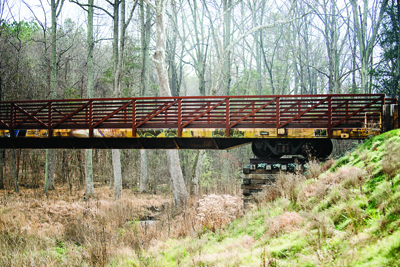
The redesign of Keswick Hall’s Full Cry included numerous unique touches, including the conversion of an old railroad car into a bridge leading to the tee on the course’s 17th hole.
Photos by Ashley Twiggs
Come together
It wasn’t until McDonough came to north-central Virginia to take over maintenance responsibilities at the Keswick Club that the importance of the lessons he had learned about environmental responsibility, communications and partnerships came into complete focus.
He attributes some of that to geography. In Charlottesville, he found a community that embraced its past — Monticello, the famed home of Thomas Jefferson, is just a stone’s throw from the Keswick Club — as enthusiastically as it protected its future. Looking at things through an environmental lens wasn’t just an option in this part of the world. It was a requirement.
“You have the Southern Environmental Law Center and the Piedmont Environmental Council right here, some of the biggest environmental groups in the country,” McDonough says. “It doesn’t take long to get the message that we all have to share and we all have a part to play around here.”
The rest of that awakening to the power of collaboration, he credits to circumstance. When he arrived on the scene in Virginia, he quickly became involved with the Old Dominion GCSA, one of five superintendent chapters in the state (but the only one that was affiliated with GCSAA at the time). Those chapters generally got along and worked well on issues of common concern, but McDonough recognized how much more could be accomplished by a united front representing the state’s golf course management industry.
So McDonough spearheaded an effort to create a statewide chapter, an umbrella organization better positioned to advocate for all Virginia superintendents. McDonough would serve as the first president of the Virginia GCSA in 1999 and 2000 (and again in 2001 and 2002), and would later receive the chapter’s President’s Lifetime Service Award for the role he played in getting the organization off the ground.
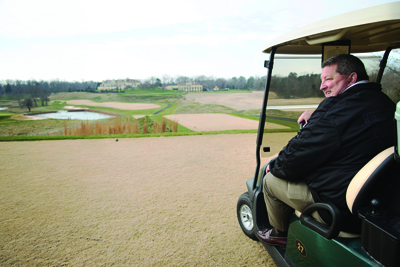
McDonough played a key role in the creation of the Virginia GCSA upon his arrival in the state, receiving the chapter’s
President’s Lifetime Service Award for his efforts.
“We had five of everything — five chapters, five boards, five groups of sponsors, five newsletters,” McDonough says. “There was so much more we could accomplish as one, to demonstrate what our industry really was and how we manage our golf courses.”
Solutions for the real world
It didn’t take long for that newfound unity to be put to the test. In 2002, Virginia suffered through a drought that is recognized as the most severe in the state’s history. Among the first steps the state government took to combat that drought was to simply shut off the taps, to limit the amount of water available to commercial outfits such as golf courses.
That didn’t sit well with the state’s superintendents, including McDonough. “My first reaction was, ‘Are you kidding me?’ That just told me there were a lot of misconceptions about golf’s role on many fronts. I knew shutting off the water to all the golf courses wasn’t a solution.”
Working collaboratively with the state government, however, was a solution. McDonough spent countless hours meeting with the governor’s office, Virginia’s Department of Environmental Quality and a host of state legislators to convince them that abstinence wasn’t the best policy in facing the drought, and that there were other steps — rooted in science and common sense — that could be taken that would not only save water, but would also help keep golf courses in business.
And when he did that work, he did so on behalf of more than just the state’s superintendents. In a precursor to what would become the Virginia Golf Council, McDonough carried the flags for the entirety of the state’s golf industry — golf professionals, club managers and owners alike — into those discussions, taking what he’d learned from the unification of the state’s GCSAA chapters to the next level.
In the end, Virginia’s golf courses got what they needed out of those efforts in Richmond: realistic and achievable water rules that wouldn’t threaten their businesses. And government officials in the state of Virginia got a little something, too: an introduction to a group of professionals that it knew it could work with moving forward on initiatives that would benefit those on both sides of the table.
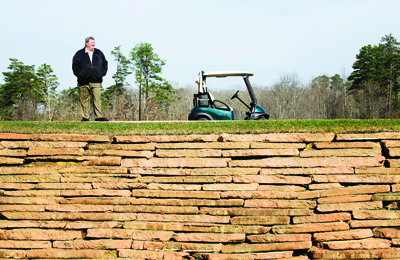
McDonough is particularly proud of one aspect of the redesign of the Full Cry Course at Keswick Hall: the repurposing of the course’s old cart paths into Dye’s signature retaining walls throughout the property.
“Peter McDonough is someone special in the area of advocacy. He’s someone who can see beyond the horizon, someone who is progressive, collaborative, thoughtful when it comes to positioning golf course superintendents well in the eyes of policymakers, regulators, the public and the media,” says Chava McKeel, GCSAA’s director of government affairs about McDonough, who was awarded the Virginia GCSA Distinguished Service Award in 2003 for his efforts during the drought emergency.
Cleaning the Bay
Energized by his time working with legislators and regulators, and the far-reaching successes that sprung from those efforts, McDonough again found himself in a lead role in 2011 when attention turned to the Chesapeake Bay, its failing health and ways in which it could be restored. And once again, it was the power of partnership that helped cement golf’s positive role in those efforts.
Early on, the green industries as a whole often found themselves in a defensive position, taking heat — both warranted and unwarranted — for their use of fertilizers and the impacts those nutrients were having on the Chesapeake Bay, regardless of whether there was any correlation between the two.
But instead of lying low and waiting for the storm to pass, McDonough led a team representing the Virginia Golf Council, the Virginia Agribusiness Council and other green industry players into proactive discussions with the state of Virginia about the roles they could all play in improving the Chesapeake Bay.
The team demonstrated how their constituents actually used those nutrients in the real world and steps they could reasonably take to monitor their use. For golf’s part, that meant taking the state’s voluntary nutrient management plans and creating a more permanent set of best management practices that would be required for golf courses in the state beginning in 2017.
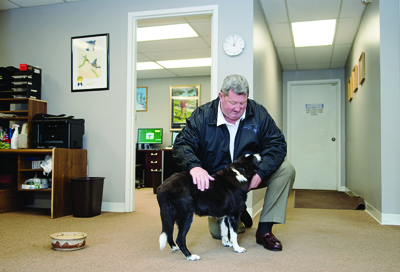
McDonough and Wendy, one of his loyal assistants at Keswick Hall.
Those BMPs — known officially as the “Best Management Practices for Virginia Golf Courses” (www.vgcsa.org/bmps) — have not only furthered the broader recognition of golf’s environmental stewardship in Virginia, but have also become a model for other states to follow. And McDonough has become a bit of an expert on the subject, consulting with chapters across the country on creating BMPs of their own and presenting on the topic during the 2014 Golf Industry Show in Orlando.
“I think far and away the biggest thing we’ve done as a chapter is the BMPs,” says David Norman, the executive director of the Virginia GCSA. “I’ve been asked to present in front of other chapter leaders on what we did here, and when I’ve done that, I’m telling Peter’s story. Other chapters are exploring BMPs. GCSAA and the USGA are getting together to write a template for BMPs. In my mind, Peter is the father of all of that.”
For his part, McDonough sees those BMPs, as well as golf’s inclusion in a state environmental stewardship bill that was signed into law in 2011, as proof of just how valuable partnerships can be in these processes. He credits Donna Johnson, the former president of the Virginia Agribusiness Council, with opening many of the doors that golf has been able to step through in the state.
“You have to actively participate, and you have to think outside the box,” he says. “Donna and the Agribusiness Council gave us all a broader view of how government policy works and the role we could play. That’s a $79 billion industry in Virginia. To be able to get a seat at that table and then set ourselves apart with the BMPs, that was just huge.”
Stewardship at home

Keswick Hall itself was originally built in 1912 as a residence for Charlottesville doctor Robert Crawford and his family. Golf first became part of the property in 1948.
Photo by Ken May
With so much of his efforts focused externally, it’s easy to overlook just how much McDonough has invested on the home front and in the course he manages at Keswick Hall. Dubbed “Full Cry,” the 7,100-yard layout is a recent Pete Dye redesign of an original Arnold Palmer tract that reopened for play a little more than a year ago.
But as McDonough explains, “I don’t even want to use the word ‘renovation.’ It’s more like a whole new golf course. It’s built within the same corridors as the old course, but they’re all new holes. The pars on the holes are different. How you play them is different. Pete redid the whole thing, top to bottom.”
The one thing the 90-year-old master golf course architect didn’t disrupt, however, were the many environmental features that McDonough has nurtured in his nearly two decades at the facility. And, in some cases, the work allowed him to build on those achievements. McDonough is particularly proud of the course’s new cart paths, the first in the country to use Porous Pave, a permeable surface that will allow water to pass through the paths. The old cart paths were even recycled into one of Dye’s signatures, the retaining walls he used around greens, tees and bunkers throughout the property.
Full Cry first achieved Audubon International Cooperative Sanctuary certification in 2002, one of 35 Virginia courses active in the program. McDonough has guided efforts that have included the installation of 25 acres of buffer zones along the streams and ponds found on the property, and the conversion of an additional 25 acres of maintained turf to native areas and other low-maintenance vegetation.
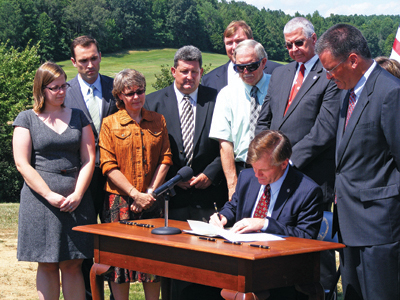
McDonough, fourth from the left, cites Gov. Bob McDonnell’s signing of an environmental stewardship bill in 2011 and golf’s inclusion in that bill as a shining example of the power of partnerships.
Photo courtesy of Peter McDonough
The Keswick Club has documented the presence of 80 different bird species on the property, as well as whitetail deer, fox, migrating geese, rabbits and squirrels. Each member of McDonough’s maintenance team undergoes annual environmental education to arm them with skills that allow them to maintain the course while still protecting natural resources.
‘Just be there’
The renovation project at Keswick Hall took nearly two years to complete and, understandably, put a bit of a crimp in McDonough’s ability to take on outside causes. But with that in the rearview mirror, he’s looking forward to re-engaging in those efforts. He’s getting reacquainted with the Virginia GCSA’s government relations committee, and he’s hoping to participate in National Golf Day activities in Washington, D.C., this May. He’s also on board as a participant in GCSAA’s Grassroots Ambassador program.
As McDonough sees it, half the battle when it comes to environmental stewardship and advocacy is just showing up. And he plans to keep showing up.
“You’ve got to be there, just be there,” he says. “Presence equals perception in a lot of circles.
“The other part of all this for me is I’ve made a lot of new friends I would’ve never met. I’ve learned so many things I never would’ve learned. When I look back on all I’ve been involved with, I never, ever would have been exposed to so many things that are important to me now if I hadn’t gotten involved.”
Scott Hollister is GCM’s editor-in-chief.